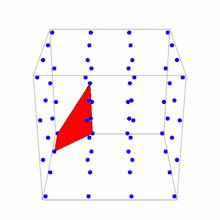Reeve tetrahedron

In geometry, the Reeve tetrahedron is a polyhedron, named after John Reeve, in ℝ3 with vertices at (0, 0, 0), (1, 0, 0), (0, 1, 0) and (1, 1, r) where r is a positive integer. Each vertex lies on a fundamental lattice point (a point in ℤ3). No other fundamental lattice points lie on the surface or in the interior of the tetrahedron. In 1957 Reeve used this tetrahedron as a counterexample to show that there is no simple equivalent of Pick's theorem in ℝ3 or higher-dimensional spaces.[1] This is seen by noticing that Reeve tetrahedra have the same number of interior and boundary points (0 and 4) for any value of r, but different volumes.
The Ehrhart polynomial of the Reeve tetrahedron Tr of height r is
Thus, for r ≥ 13, the Ehrhart polynomial of Tr has a negative coefficient.
Notes
References
- Kołodziejczyk, Krzysztof (1996). "An 'Odd' Formula for the Volume of Three-Dimensional Lattice Polyhedra". Geometriae Dedicata. 61: 271–278.
- Beck, Matthias; Robins, Sinai (2007). Computing the Continuous Discretely, Integer-point enumeration in polyhedra. Undergraduate Texts in Mathematics. New York: Springer-Verlag. ISBN 978-0-387-29139-0. MR 2271992.